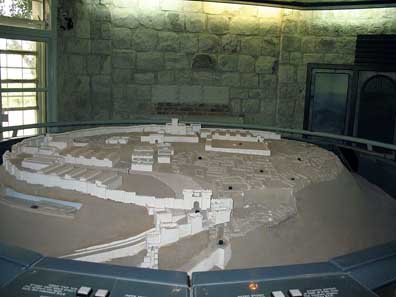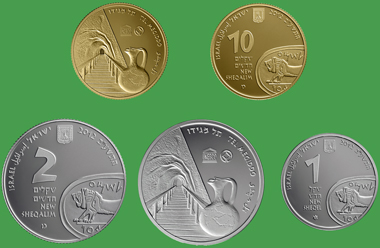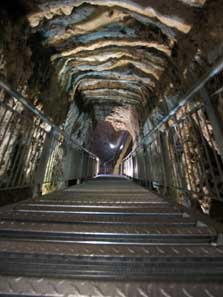October 18, 2012 – A site in northern Israel that dates back to the third millennium BCE, made worldwide news this past spring when a team of archeologists from Tel Aviv University disclosed a miraculous discovery at Tel Megiddo, in the Jezreel Valley, about 18 miles (30 km) southeast of Haifa. Tel Megiddo is no stranger to excavations, having hosted them in 1903, 1925, and somewhat regularly since the 1960s. In the summer of 2010, while digging in an ancient courtyard, the archeologists found a jug wrapped in textile so packed with dirt that it took two years to assess the find.
Only after it was removed to a restoration laboratory and carefully washed out and examined, could it be announced on May 20, 2012 that they had found a priceless Canaanite treasure trove. The find was exceptional both for its 3,100 year old age, making it attributable to the Iron Age (c.1,000 BCE), and for its extraordinary value. It included nine pairs of gold moon-shaped earrings, a gold ring with a seal, and an unusual gold earring decorated with wild goats. In addition, there were over one thousand beads made from gold, silver and semi-precious carnelian and a number of silver jewelery pieces. According to researchers, it is possible that the remains of the house in which it was found belonged to a wealthy, or perhaps even royal Israelite family.
A model of Megiddo. Photo: James Emery / Wikipedia.
It is not surprising that the Bank of Israel chose to depict such a jug, along with a tunnel from the ancient city’s water system thought to date to the ninth century BCE on a new coin featuring Tel Megiddo. This is the fourth in a series dedicated to UNESCO World Heritage Sites in Israel. The theme side of the coin also contains ‘Tel Megiddo’ in English, Hebrew and Arabic, the UNESCO World Heritage Site Emblem and the Israel UNESCO Emblem. The obverse, or front side has the face value, ‘Israel’ in English, Hebrew and Arabic, the date, Israel’s State Emblem and part of an ancient 8th century BCE seal discovered at Megiddo. The design is by Osnat Eshel.
The new coin is available in gold and silver.
The coin is offered in three variations: A gold proof-quality 10 New Sheqel (NIS) is 30 mm in diameter with 16.96 grams of .917 fine (22kt) gold. Mintage is limited to only 555 pieces. There are two sterling silver coins. A proof quality 2 NIS measuring 38.7 mm (1.5 in.) and weighing 28.8 grams with mintage restricted to 2,800 coins, and a 30 mm, 14.4 gram 1 NIS in proof-like condition limited to 1,800 coins. A set of all three coins and just the two silver ones are also available.
Now a national park, Tel Megiddo is visited by thousands annually, some certainly because of the eleven biblical references there are to it. The Prophet Zechariah (12:11) called it “Megiddon” and provided an apocalyptic description of a world war. In the New Testament, Megiddo is referred to as ‘Armageddon’ and according to the Book of Revelation, it is here where the final battle will take place between good and evil forces, at the end of days.
Megiddo was already an important city in the Bronze and Iron Ages, corresponding to the Canaanite and Israelite periods, and reached its peak in the time of King Solomon. Strategically guarding the pass to an ancient trade route connecting Egypt and Assyria, it was desired by many ruling powers and was the site of frequent battles. Among its conquerors were Pharaohs of ancient Egypt, the Israelite and Judean Kings, as well as Assyria. Towards the end of the 7th century BCE, at the Battle of Megiddo between Egypt and the Kingdom of Judah, Pharaoh Neco, captured the city from the Assyrians and slew King Josiah of Judah.
Tel (Settlement Mound) Megiddo is one the most important and impressive archeological sites in the Land of Israel. Its archeological strata contain the remains of some 20 different cities, spanning a period of over 4,000 years. Excavations which have been carried out since 1903, have revealed altars, a large palace with jewels and ivories, stables from the time of King Ahab (I Kings 16-22, 9th Century BCE ) and an 8th century BCE seal with a roaring lion, belonging to Shema, the servant of King Jeroboam II.
A look into the impressive Megiddo water system taken from the bottom of the last set of stairs. Photo: James Emery / Wikipedia.
In addition and most impressive of all the findings, is the fine water system featured on the coins and dating from the Israelite period. Initiated in the 10th century BCE, when Megiddo was one of three royal centers, the elaborate water system safeguarded the city’s water supply in times of siege. It consisted of a 25 meter-deep vertical shaft and a subterranean 80 meter-long horizontal tunnel, which had been painstakingly cut in the rock on the western side of the city, making it possible to reach the spring outside the city walls without being seen by the enemy.
Representing an interchange of human values throughout the ancient near-east and being a testimony to an ancient civilization with a high level of engineering and technology, Tel Megiddo was recognized by UNESCO as a World Heritage Site in 2005.
More information on all Israeli coin and medal issues is available online here and here.
To learn more about this important site, visit The Megiddo Expedition.
You can look at Tel Megiddo from the air watching the YouTube clip ‘Flying over Tel Megido’.






